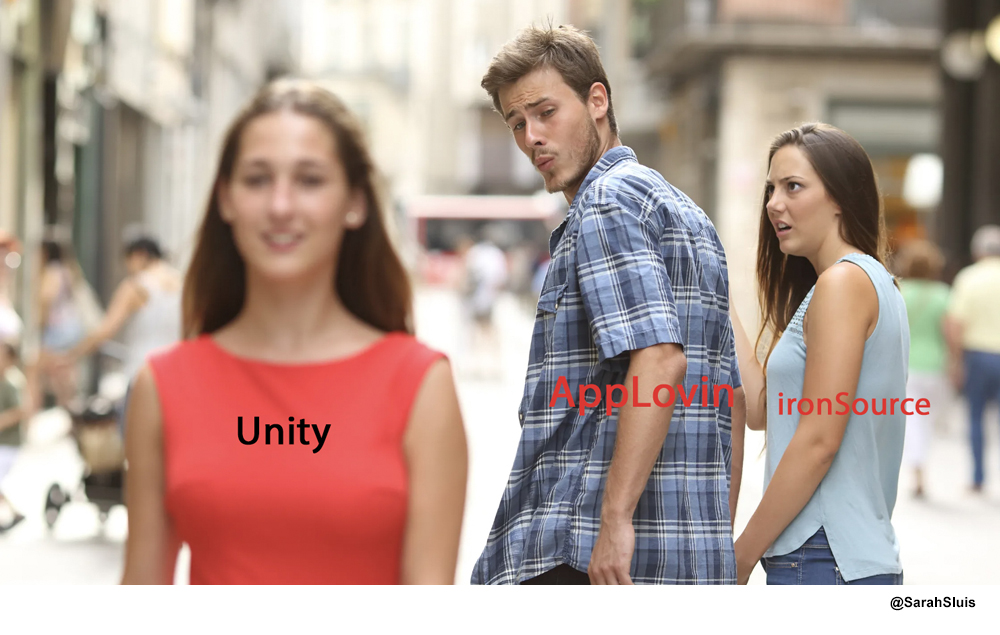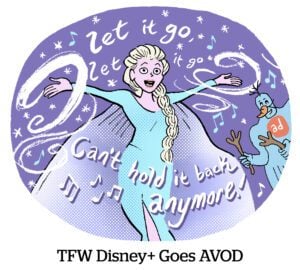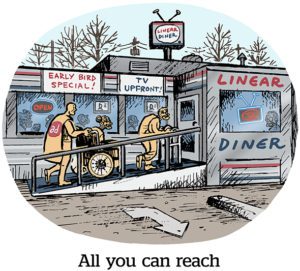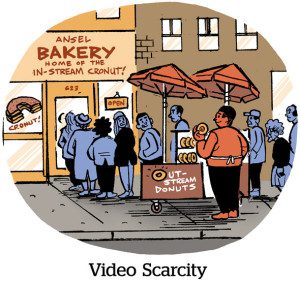AppLovin wants to marry Unity. Unity just got engaged to ironSource. IronSource is still waiting at the restaurant with flowers. But Unity hasn’t quite made up its mind yet.
And now you’re up to date, in case you weren’t following this week’s drama.
If Unity does decide to pull out of its planned $4.4 billion merger with ironSource and accept AppLovin’s $20 billion all-stock offer, the combined AppLovin/Unity would take Unity’s name. Unity CEO John Riccitiello would become CEO of the whole shebang and AppLovin’s CEO, Adam Foroughi, would be the COO.
Riccitiello declined to comment on AppLovin’s proposal during Unity’s Q2 earnings on Wednesday.
In a letter sent to ironSource employees this week, CEO Tomer Bar-Zeev called AppLovin’s bid “a defensive and desperate measure.”
AppLovin CFO Herald Chen said on his company’s earnings call on Wednesday that the offer is a “unique partnership proposal,” so … potayto, potahto?
But what does Foroughi have to say about it? He got into the rationale with investors during AppLovin’s Q2 call.
(The TL;DR on AppLovin’s earnings: Apps revenue was down, software revenue was up, guidance for the apps business was revised downward, guidance for the software side of the house stayed stable and the company’s stock dipped on the news.)
Why now?
AppLovin and Unity had previously discussed “the strategic rationale” of coming together, but the timing never made sense, Foroughi said.
Until recently, AppLovin’s ad tech business was very similar to Unity’s Operate division, which houses its monetization teams and technology.
But a lot changed over the past few years.
AppLovin launched a machine-learning-powered recommendation platform called Axon to support its ad network and went on to acquire Adjust and MoPub over the course of less than one year. AppLovin recently integrated MoPub into MAX (AppLovin’s in-app bidding tool).
The growth of Axon, which targets in-app ads for other apps based on a user’s likelihood to download, together with the addition of monetization and attribution technology into AppLovin’s stack, changed the calculus. “We now see a path to unlocking very meaningful synergies by bringing the two companies together,” Foroughi said.
The math
But about those “synergies.”
In AppLovin’s view, combining with Unity into a full-stack solution could lead to more than $700 million in pre-tax earnings by 2025.
AppLovin’s math goes as follows: AppLovin generated $88 million in software revenue in Q1 2021 (which was also its first full quarter with Axon in its stack). Unity’s Operate revenue was $146 million during that same time period. In Q2 of this year, AppLovin’s software revenue was $318 million compared with $158 million for Unity Operate.
In short, Axon has been growing exponentially, but access to more first-party data would help further strengthen the algorithms, and Unity’s Create business (the game creation engine side of the house) would be able to supply it.
“If you take those two businesses and allow them to tap into that same underlying data … and the same algorithms, the unlock could potentially be huge,” Chen said. “It’s more scale, more customer reach, more data – all coming into the same place.”
(Alternative cold water POV: “We see AppLovin’s bid for Unity as another attempt by mobile ad networks to ‘huddle together’ and bury the bad news of underlying guidance cuts,” according to Richard Kramer, managing director and founder of equity research firm Arete Research, in a note to investors on Tuesday.)
What’s next?
Before anything can happen with AppLovin, it’s up to Unity’s board, which has to, well, get on board – and also back out of the ironSource deal.
In the meantime, AppLovin isn’t going to wait by the (mobile) phone, but rather continue to focus on its three strategic priorities: expanding the reach of its software platform, improving Axon and optimizing its cost structure – all necessary moves in the face of macroeconomic headwinds.
But the mobile ecosystem is also facing industry-specific headwinds.
Although the overall consumption of mobile gaming apps “remains stable,” AppLovin said in its Q2 letter to shareholders that mobile consumer spending is down compared to last year (when the hottest bar in town was … your sofa).
Also, platform privacy changes – Apple’s AppTrackingTransparency in particular – has dramatically changed how developers approach (and spend on) growth and user acquisition.
Economic uncertainty compounds these headwinds, the letter says, leading to further softening in the mobile gaming market.
AppLovin lowered its 2022 sales guidance for its apps business, with the projected range now falling between $1.7 billion and $1.85 billion rather than between $2 billion and $2.15 billion.
The company also laid off 12% of its workforce in Q2, which mainly hit AppLovin’s apps segment. In May, AppLovin told investors that it planned to restructure its app business as part of a long-term plan to invest more in the software side.














